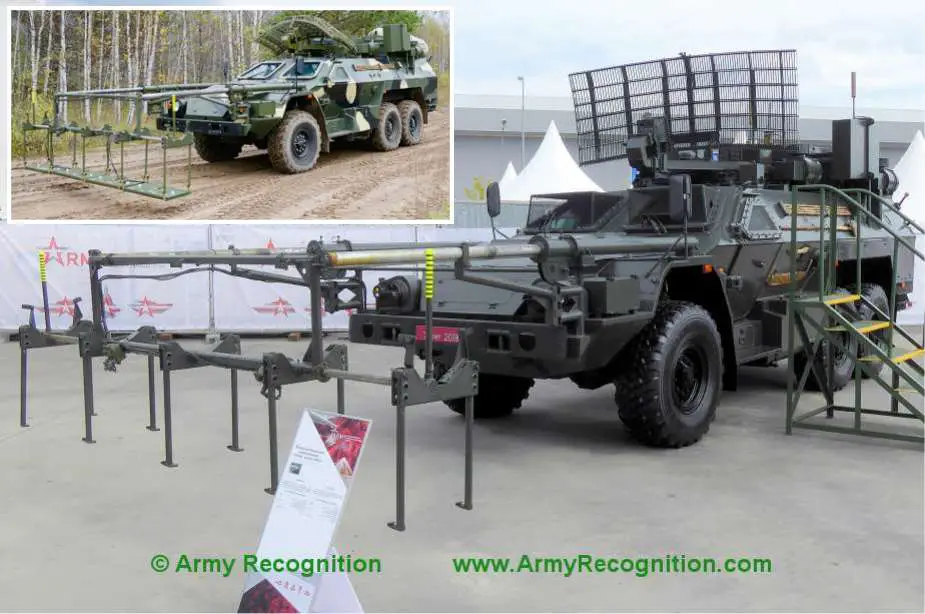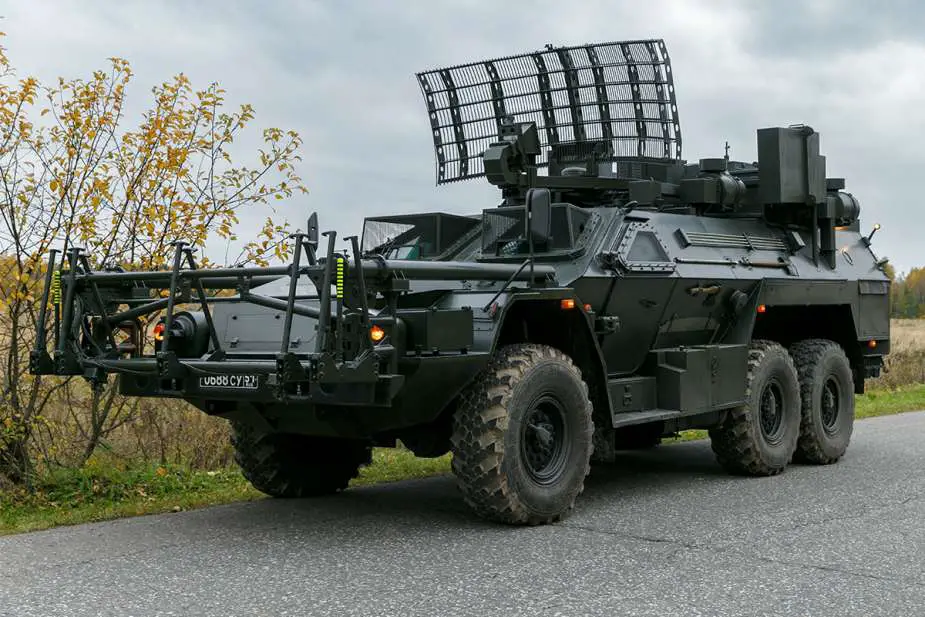Breaking news
Russian Listva mine-clearing vehicle's new microwave gun targets Ukrainian modern mines.
On August 17, 2023, Ruselectronics, a branch of Rostec State Corporation, announced the development of a new microwave gun for the 15M107 Listva remote-controlled mine-clearing vehicle (RMCV) in response to the challenges posed by modern anti-tank mines, as seen in conflict zones including Ukraine. The aim is to enhance the Listva MCV's capability to neutralize modern mines equipped with semiconductor electronics.
Follow Army Recognition on Google News at this link

Russian Listva mine-clearing vehicle's new microwave gun will target Ukrainian modern mines (Picture source Army Recognition and Yandex)
The Research Institute of Measuring Instruments-Komintern Novosibirsk Plant Research and Production Association, in collaboration with the Kaskad Instrument Plant under Ruselectronics, independently conducted engineering assessments for upgrading the microwave component of the Listva RMCV.
This upgrade is expected to increase the emitted signal's power flux density to around 10 W/cm2 at a range of 50–80 meters. The intention is to improve the effectiveness in damaging improvised explosives and modern IEDs containing semiconductor electronic components, as highlighted by Ruselectronics.
Experts from Ruselectronics overseeing the microwave gun's upgrade and integration are also considering a shift to a direct drive mechanism for the microwave unit's rotational support system. This change is aimed at enhancing the radiating antenna's positional accuracy based on azimuth measurements. Additionally, Ruselectronics plans to enhance the jamming station with a more advanced, higher-capacity unit capable of operating within a bandwidth of up to 6,000 MHz.
The Listva remotely controlled mine-clearing vehicle is set to receive an automated video surveillance system. This development is timely, given the increasing use of improvised explosive devices (IEDs) and mines in various conflict zones. Both Russian and Ukrainian forces have reportedly employed such devices as defensive measures.
The Listva MCV employs an induction wide-span search module to detect both manually and automatically operated improvised explosive devices (IEDs) and mines. Electromagnetic radiation is used to disable explosive devices and mines containing electronic components. The vehicle's crew, including sappers, decides whether to demine the explosives or initiate a controlled explosion if a pressurized mine is detected.
To prevent unauthorized detonation of electronic or remotely controlled mines, portable and stationary electronic jamming equipment with a 70-meter radius is used. The Listva MCV features devices that can detect metal-containing explosives while moving at a speed of 15 km/h within a range of one hundred meters. Positioned at the front of the vehicle is a wide-span multi-zone search module equipped with 16 induction sensors, complemented by electromagnetic situational control equipment.
This new microwave gun is anticipated to be effective against mines containing semiconductor elements. Electronic mines are rendered ineffective through a parabolic antenna located on the vehicle's top, emitting a potent microwave signal across the entire sector of the vehicle's operation. This microwave emission spans a mine clearance width of 50 meters, effectively neutralizing electronic mines without causing destruction. The Listva vehicle also possesses the capability to counter remotely detonated explosives, often triggered using cellular phones. The vehicle can emit impulses that replicate signals from cellular phones and other electronic devices.

The Listva mine-clearing vehicle was designed for the Russian Strategic Missile Forces (picture source : Yandex)
Developed for the Russian Strategic Missile Forces, the Listva remote-controlled demining vehicle is primarily designed to detect and neutralize explosives along routes used by missile launchers like Topol, Topol-M, and Yars. By 2020, Russian Strategic Missile Forces engineering divisions were expected to receive about new 20 Listva RMCV and approximately 50 engineering support and concealment vehicles.
The Listva is derived from the SBA-60K2 Bulat, an armored personnel carrier developed by Kamaz and Zaschita corporation. Constructed on the KamAZ-5350 6x6 utility truck chassis, the Bulat serves various roles, including troop and equipment transport, patrol, and convoy escort. It is powered by a KamAZ-740.31-240 turbocharged diesel engine generating 240 hp, offering an operational range of around 1,000 km. The vehicle's V-shaped hull provides protection against small arms fire, artillery shrapnel, and resistance against mine and IED blasts up to the equivalent of 1 kg of TNT.
In terms of capabilities, the SBA-60K2 Bulat can be equipped with a remotely controlled 7.62mm or 12.7mm machine gun. It includes a central tire inflation system and a self-recovery winch. The vehicle can navigate water obstacles up to 1.2 meters deep without prior preparations. It is also designed to handle side slopes of up to 30%, gradients of 60%, and trenches up to 0.6 meters wide.
Microwave weaponry, similar to laser weapons, falls into the category of directed energy weapons that focus electromagnetic radiation onto a target by converting power from a source, such as a military vehicle's engine, into radiated energy. High-powered microwaves, when concentrated, can incapacitate machinery, particularly electronics, without posing harm to individuals in close proximity. This characteristic has led several technologically advanced armed forces, including the United States and China, to consider directed energy weapons due to their cost-effectiveness, precision, and minimal collateral damage.























